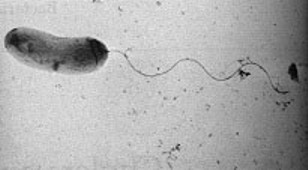Vibrio cholerae: Difference between revisions
No edit summary |
|||
| Line 25: | Line 25: | ||
==Genome structure== | ==Genome structure== | ||
In 1998 it discovered that V. cholerae contains two circular chromosomes.[3] Only two years later the entire genome of the virulent strain El Tor N16961 had been sequenced. [1] Chromosome 1 has 2,961,149 base pairs with 2,770 open reading frames (ORF’s) and chromosome 2 has 1,072,315 base pairs, 1,115 ORF’s. It is the larger first chromosome that contains the crucial genes for toxicity, important cellular functions (such as transcription and translation) and regulation of toxicity. | |||
Does it have any plasmids? | |||
Other interesting features? | |||
What is known about its sequence? | |||
Does it have any plasmids? | |||
Are they important to the organism's lifestyle? | |||
==Cell structure and metabolism== | ==Cell structure and metabolism== | ||
Revision as of 04:07, 8 May 2007
A Microbial Biorealm page on the genus Vibrio cholerae
Classification
Higher order taxa
Bacteria; Proteobacteria; Gammaproteobacteria; Vibrionales; Vibrionaceae; Vibrio
Species
|
NCBI: Taxonomy |
Vibrio cholerae
Description and significance
Gram-negative pathogenic bacteria Describe the appearance, habitat, etc. of the organism, and why it is important enough to have its genome sequenced. Describe how and where it was isolated. Include a picture or two (with sources) if you can find them.
Genome structure
In 1998 it discovered that V. cholerae contains two circular chromosomes.[3] Only two years later the entire genome of the virulent strain El Tor N16961 had been sequenced. [1] Chromosome 1 has 2,961,149 base pairs with 2,770 open reading frames (ORF’s) and chromosome 2 has 1,072,315 base pairs, 1,115 ORF’s. It is the larger first chromosome that contains the crucial genes for toxicity, important cellular functions (such as transcription and translation) and regulation of toxicity.
Other interesting features? What is known about its sequence? Does it have any plasmids? Are they important to the organism's lifestyle?
Cell structure and metabolism
Describe any interesting features and/or cell structures; how it gains energy; what important molecules it produces.
Ecology
Describe any interactions with other organisms (included eukaryotes), contributions to the environment, effect on environment, etc.
Pathology
How does this organism cause disease? Human, animal, plant hosts? Virulence factors, as well as patient symptoms.
Application to Biotechnology
Does this organism produce any useful compounds or enzymes? What are they and how are they used?
Current Research
Enter summaries of the most recent research here--at least three required
References
1. DNA sequence of both chromosomes of the cholera pathogen Vibrio cholerae, Nature 406 (6795), 477-483 (2000)
2. Center for Disease Control, Coordinating Center for Infectious Diseases / Division of Bacterial and Mycotic Diseases, October 6, 20005. http://www.cdc.gov/ncidod/dbmd/diseaseinfo/cholera_g.htm
3. Trucksis, M., Michalski, J., Deng, Y. K. & Kaper, J. B. The Vibrio cholerae genome contains two unique circular chromosomes. Proc. Natl Acad. Sci. USA 95, 14464-14469 (1998).
Edited by student of Rachel Larsen

